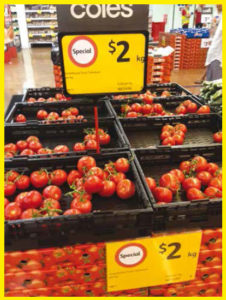 A phrase I often quote is “If you do what you’ve always done, you’ll get what you’ve always got.”
A phrase I often quote is “If you do what you’ve always done, you’ll get what you’ve always got.”
While this often holds true, the same can’t be said for the current prices of tomatoes – or can it?
The low prices pictured on the left are not what we have always “got”.
A retail price of $2 / kg would equate to a grower payback price of $1 / kg or less.
So the question really is, “Can we really afford to do what we have always done?”
In a previous edition of Soilless Australia magazine (Volume 4, 2005), our then President Graeme Smith wrote an article on the costs involved of setting up and operating a greenhouse and how it can vary according to scale.
An example showed what could be achieved for tomato production in 2005.
The figures were based on a greenhouse of 3,840m2 at a production rate of 48.7 kg / m2.
2005 Gross income $3.02 kg
2005 Annual costs $1.70 kg
2005 Nett return $1.32 kg
Some would say that these were the ‘glory days’ in 2005 when the gross income was $3.02 kg compared to what growers are realising in 2016.
Also after 10 years of CPI the annual cost of $1.70kg has increased since then too.
In fact, based on the 2005 figures a sale price of $1 kg equates to a $0.70 kg loss.
The more you sell at these prices, the quicker you go broke, so things are looking grim!!
There are a few things to note on this discussion.
Firstly, the example shown above is based on a production area of 3,840 m2 which is now considered quite small.
Secondly, the tomatoes available back then were the regular truss or singular varieties. Nowadays truss tomatoes are being grown in high-tech glasshouses which are often in multiples of 10 Ha.
This provides a scale of economy with which a smaller grower simply cannot compete, especially with the same product.
Is a retail price of $2.00 kg sustainable for the larger grower? I suspect not, but averaged out for the year such low return on investment must stack up.
There needs to be some serious discussions with retailers, to ensure large growers are in business next year.
What about the small to medium-sized grower?
Well clearly, unless what they are doing is working they cannot do what they have always done.
However there is scope for a small to medium-sized grower to be flexible, adaptable and to specialise to maximise profits.
We are living in challenging times and with more production area scheduled for 2016/17 it will only exaggerate the issue.
Two characteristics to ensure long term viability are to remain flexible and adaptable.
How to protect your greenhouse business
- Talk to your customers to see what other styles of tomatoes they sell that you might grow.
- Do your customers have difficulty in sourcing other lines that you might be able to supply.
- Can you find smaller customers who would benefit from sourcing direct from you?
- Organic produce?
- Heirloom varieties?
- Grow a high-end product in your high-end growing system.
- Negotiate a fixed or minimum price for guaranteed supply/
- Retail what you grow.
Marcus Brandsema,
PCA Director + tomato grower
